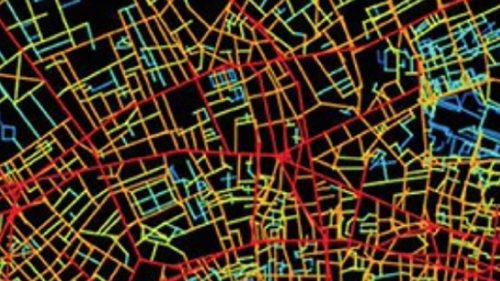The below is an excerpt from “Hippocampal and prefrontal processing of network topology to simulate the future” previously published by Nature Communications in 2017.
Evidence from neuropsychology, neuroimaging and electrophysiology indicates that the hippocampus supports retrieval of the past to simulate the future1-5. However, prior results have mainly come from tasks requiring cued mental simulation of the future. Thus, the conditions under which the hippocampus might naturally represent information needed for the future during continuous interaction with an environment remain unknown. One candidate moment is the transition between episodes, when new options for action arise.
For all motile animals one transition is universally important: crossing spatial boundaries. When we enter a new territory, future possible paths become available, which are defined by the topology of the environment. Recent evidence from rodents has shown that the connections between spaces are over-represented by the spatial localized firing of hippocampal place cells6, and it has been argued that hippocampal place cells may preferentially code the topology of an environment rather than its geometry7. During ‘off-line’ hippocampal replay events, when hippocampal place cells show re-activation of spatial sequences, the topological structure of an environment may be re-capitulated8. Such simulation of the topological structure of the environment would be useful during active navigation; however, so far little evidence for ‘online’ representation of topological network properties of an environment has been observed.
While the hippocampus is thought to support retrieval of memory representations to simulate future possibilities, the role of evaluating possible future states for action is argued to be the preserve of the prefrontal cortex (PFC). This is based on evidence that damage to the PFC specifically impairs planning and problem solving9-10. However, it is not currently clear which regions of the PFC evaluate future paths or whether information contained in topological structures is searched to support navigation. We have recently proposed that the lateral frontopolar PFC is a suitable candidate region10. The mechanism by which path evaluation may occur is not known. One potential mechanism is a ‘tree-search’ of all the future branching choices in the network. Consistent with this, recent evidence indicates that humans plan their decisions based on evaluation of each level of the decision tree before proceeding to the next level11,12. For a street network this would involve searching retrieved representations of all the possible path streets just beyond the next junction. Such a search mechanism is known as a breadth-first search (BFS)13, which steps through the sequences of possible future choices one level of the decision tree at a time. Prior evidence suggests that humans may use this mechanism when planning routes from cartographic maps14.
Here we tested the hypotheses that the hippocampus retrieves representations of the topological structure of the environment when new paths are entered in order to support goal-directed navigation and the lateral PFC performs path-planning via a BFS mechanism. We combined a graph-theoretic analysis of the city streets of London with functional magnetic resonance imaging (fMRI) data collected from participants navigating a film simulation of London’s streets. Our analysis reveals that the right posterior hippocampus specifically tracks the changes in the local connections in the street network, the right anterior hippocampus tracks changes in the global properties of the streets and the bilateral lateral prefrontal activity scales with the demands of a BFS. These responses were only present when long-term memory of the environment was required to guide navigation.
References
- Hassabis D, Maguire EA. The construction system of the brain. Philos. Trans. R. Soc. Lond. B Biol. Sci. 364, 1263–1271 (2009).
- Erdem UM, Hasselmo M. A goal-directed spatial navigation model using forward trajectory planning based on grid cells. Eur. J. Neurosci. 35, 916–931 (2012).
- Byrne P, Becker S, Burgess N. Remembering the past and imagining the future: a neural model of spatial memory and imagery. Psychol. Rev. 114, 340 (2007).
- Olafsdottir HF, Barry C, Saleem AB, Hassabis D, Spiers HJ. Hippocampal place cells construct reward related sequences through unexplored space. Elife 4, e06063 (2015).
- Schacter DL. et al. The future of memory: remembering, imagining, and the brain. Neuron 76, 677–694 (2012).
- Spiers HJ, Hayman RMA, Jovalekic A, Marozzi E, Jeffery KJ. Place field repetition and purely local remapping in a multicompartment environment. Cereb. Cortex 25, 10–25 (2015).
- Dabaghian Y, Brandt VL, & Frank LM. Reconceiving the hippocampal map as a topological template. Elife 3, e03476 (2014).
- Wu X, Foster DJ. Hippocampal replay captures the unique topological structure of a novel environment. J. Neurosci. 34, 6459–6469 (2014).
- Shallice T, Burgess PW. Deficits in strategy application following frontal lobe damage in man. Brain 114, 727–741 (1991).
- Spiers HJ, Gilbert SJ. Solving the detour problem in navigation: a model of prefrontal and hippocampal interactions. Front. Hum. Neurosci. 9, 125 (2015).
- Huys QJ. et al. Bonsai trees in your head: how the Pavlovian system sculpts goal-directed choices by pruning decision trees. PLoS Comput. Biol. 8, e1002410 (2012).
- Huys QJ. et al. Interplay of approximate planning strategies. Proc. Natl Acad. Sci. USA 112, 3098–3103 (2015).
- Russell S, Norvig P. AI a modern approach. Learning 2, 4 (2005).
- Elliott R, Lesk M. in Proceedings of Association for the Advancement of Artificial Intelligence Conference on Artificial Intelligence 258–261 (AAAI-82, 1982).

